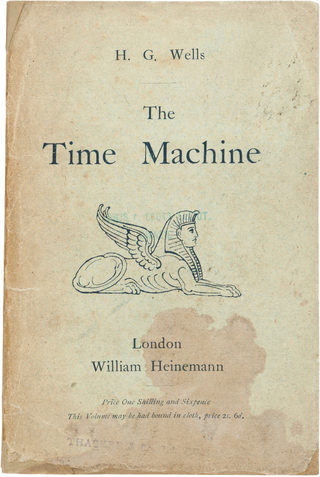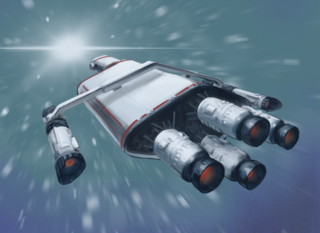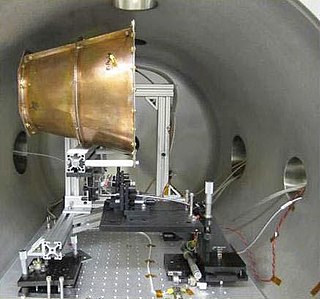Faster-than-light travel and communication are the conjectural propagation of matter or information faster than the speed of light. The special theory of relativity implies that only particles with zero rest mass may travel at the speed of light, and that nothing may travel faster.

Interstellar travel is the hypothetical travel of spacecraft from one star system, solitary star, or planetary system to another. Interstellar travel is expected to prove much more difficult than interplanetary spaceflight due to the vast difference in the scale of the involved distances. Whereas the distance between any two planets in the Solar System is less than 55 astronomical units (AU), stars are typically separated by hundreds of thousands of AU, causing these distances to typically be expressed instead in light-years. Because of the vastness of these distances, non-generational interstellar travel based on known physics would need to occur at a high percentage of the speed of light; even so, travel times would be long, at least decades and perhaps millennia or longer.

Spacecraft propulsion is any method used to accelerate spacecraft and artificial satellites. In-space propulsion exclusively deals with propulsion systems used in the vacuum of space and should not be confused with space launch or atmospheric entry.

Time travel is the hypothetical activity of traveling into the past or future. Time travel is a widely recognized concept in philosophy and fiction, particularly science fiction. In fiction, time travel is typically achieved through the use of a hypothetical device known as a time machine. The idea of a time machine was popularized by H. G. Wells's 1895 novel The Time Machine.

A fusion rocket is a theoretical design for a rocket driven by fusion propulsion that could provide efficient and sustained acceleration in space without the need to carry a large fuel supply. The design requires fusion power technology beyond current capabilities, and much larger and more complex rockets.

The Alcubierre drive is a speculative warp drive idea according to which a spacecraft could achieve apparent faster-than-light travel by contracting space in front of it and expanding space behind it, under the assumption that a configurable energy-density field lower than that of vacuum could be created. Proposed by theoretical physicist Miguel Alcubierre in 1994, the Alcubierre drive is based on a solution of Einstein's field equations. Since those solutions are metric tensors, the Alcubierre drive is also referred to as Alcubierre metric.

A warp drive or a drive enabling space warp is a fictional superluminal spacecraft propulsion system in many science fiction works, most notably Star Trek, and a subject of ongoing physics research. The general concept of "warp drive" was introduced by John W. Campbell in his 1957 novel Islands of Space and was popularized by the Star Trek series. Its closest real-life equivalent is the Alcubierre drive, a theoretical solution of the field equations of general relativity.

A starship, starcraft, or interstellar spacecraft is a theoretical spacecraft designed for traveling between planetary systems. The term is mostly found in science fiction. Reference to a "star-ship" appears as early as 1882 in Oahspe: A New Bible.
The Breakthrough Propulsion Physics Project (BPP) was a research project funded by NASA from 1996 to 2002 to study various proposals for revolutionary methods of spacecraft propulsion that would require breakthroughs in physics before they could be realized. The project ended in 2002, when the Advanced Space Transportation Program was reorganized and all speculative research was cancelled. During its six years of operational funding, this program received a total investment of $1.2 million.
Vacuum energy is an underlying background energy that exists in space throughout the entire Universe. The vacuum energy is a special case of zero-point energy that relates to the quantum vacuum.

Anti-gravity is a hypothetical phenomenon of creating a place or object that is free from the force of gravity. It does not refer to either the lack of weight under gravity experienced in free fall or orbit, or to balancing the force of gravity with some other force, such as electromagnetism and aerodynamic lift. Anti-gravity is a recurring concept in science fiction. Examples are the gravity blocking substance "Cavorite" in H. G. Wells's The First Men in the Moon and the Spindizzy machines in James Blish's Cities in Flight.

Miguel Alcubierre Moya is a Mexican theoretical physicist. Alcubierre is known for the proposed Alcubierre drive, a speculative warp drive by which a spacecraft could achieve faster-than-light travel.
A reactionless drive is a hypothetical device producing motion without the exhaust of a propellant. A propellantless drive is not necessarily reactionless when it constitutes an open system interacting with external fields; but a reactionless drive is a particular case of a propellantless drive that is a closed system, presumably in contradiction with the law of conservation of momentum. Reactionless drives are often considered similar to a perpetual motion machine. The name comes from Newton's third law, often expressed as: "For every action, there is an equal and opposite reaction."

The EmDrive is a concept for a thruster for spacecraft, first written about in 2001. It is purported to generate thrust by reflecting microwaves inside the device, in a way that would violate the law of conservation of momentum and other laws of physics. The concept has at times been referred to as a resonant cavity thruster.
Field propulsion is the concept of spacecraft propulsion where no propellant is necessary but instead momentum of the spacecraft is changed by an interaction of the spacecraft with external force fields, such as gravitational and magnetic fields from stars and planets. Proposed drives that use field propulsion are often called a reactionless or propellantless drive.

IXS Enterprise is a conceptual interstellar superluminal spacecraft designed by NASA scientist Dr. Harold G. White, revealed at SpaceVision 2013, designed for the goal of achieving warp travel. The conceptual spacecraft would make use of a modified version of the Alcubierre drive. Dr. White is currently running the White–Juday warp-field interferometer experiment in order to develop a proof of concept for Alcubierre-style warp travel, when possible. The Alcubierre drive uses exotic matter to travel faster than light.

LISA Pathfinder, formerly Small Missions for Advanced Research in Technology-2 (SMART-2), was an ESA spacecraft that was launched on 3 December 2015 on board Vega flight VV06. The mission tested technologies needed for the Laser Interferometer Space Antenna (LISA), an ESA gravitational wave observatory planned to be launched in 2035. The scientific phase started on 8 March 2016 and lasted almost sixteen months. In April 2016 ESA announced that LISA Pathfinder demonstrated that the LISA mission is feasible.
Negative energy is a concept used in physics to explain the nature of certain fields, including the gravitational field and various quantum field effects.

The Advanced Propulsion Physics Laboratory or "Eagleworks Laboratories" at NASA's Johnson Space Center is a small research group investigating a variety of theories regarding new forms of spacecraft propulsion. The principal investigator is Dr. Harold G. White.
The Helical engine is a proposed spacecraft propulsion drive that, like other reactionless drives, would violate the laws of physics.













